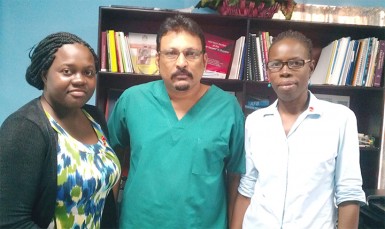The incidence rate for Tuberculosis (TB) is expected to drop significantly this year as the National Tuberculosis Programme has recorded the lowest figures for new cases ever for the first four months of this year.
“If this trend continues we will have an incidence rate of 68 per 100,000 population,” said Dr. Jeetendra Mohanlall, Programme Manager for the National Tuberculosis Programme in an interview with the Stabroek News.
Last year, the incidence rate was marked at 78 per 100,000 population. But TB treatment under the Directly Observed Treatment Short (DOTS) Programme has dragged that rate down. The DOTS Programme ensures case detection and treatment under supervision.
“We have never had such a low number in the first four months of a year,” Mohanlall said, noting that 152 new cases were recorded during that time.
He said there has been 90% success rate for TB treatment in prisons across the country.
In fact, he said they have recorded zero new cases in prisons for the year thus far. He said prisons are subjected to intensive screening, sometimes even cell by cell, for traces of the bacteria.
New inmates, he said, are screened upon entry to the prisons and a DOTS supervisor would visit the jails to oversee screening activities.
He stated that there were hiccups with the Georgetown Prison in relation to overcrowding, which in the past had caused TB staffers to be shifted around. However, he said that the TB Programme was successful at the Mazaruni Prison.

Mohanlall said HIV is the biggest risk factor for persons infected by the bacterium and also that the co-infection has the largest mortality rate for TB deaths. He stated that out of 100 cases, 60% are HIV infected.
TB is a leading killer for people who are HIV positive; they have a higher risk of dying from undiagnosed TB or TB left untreated.
However, the co-infection rate for HIV and TB has dropped somewhat in the last two years, from 29% to 25%. “HIV is a driving factor and we find that the co-infected patients are the ones who would most likely default from treatment,” he said, adding that one-third of the new cases for first part of this is HIV infected.
He said default patients place a strain on the centre to reduce the TB rate in the country because there is added pressure to track the patients and bring them back on the treatment. Miners, he noted, would stop treatment and visiting their clinics and go into mining camps, where it is hard to find them. “They would start the treatment and then disappear into the interior,” he said, adding that a default tracking team would be tasked with finding such patients.
The default rate in Region Four represents 8% of all cases; a rate which Mohanlall expects to fall. “We expect the default rate to lower and the incidence rate to reach 60 per 100, 000,” he said.
Apart from the DOTS Programme, Mohanlall said the centre had also moved to give hot meals and supligen to the homeless, who face malnutrition.
He said a team would visit the Night Shelter in the city every day to carry food and encourage the people to use their medication. He stated that the ‘Enablers Programme’ under which this activity takes place started when they realised a need to get the homeless to continue treatment.
“These activities are bearing fruits. We are seeing results from a lot of efforts but we are still working to take the number down,” Mohanlall added.
Recently, the TB unit has been working along with the US Centers for Disease Control to refurbish a rehabilitation building for TB patients. The TB Step Down Care facility is expected to be operational by the end of the year.
The building is located on the West Bank of Demerara and is expected to be fully equipped with isolation rooms for patients who need to be medicated for longer periods.
Tuberculosis is a contagious disease caused by the bacteria mycobacterium tuberculosis. When a person with TB coughs, sneezes, speaks or spits, TB bacteria are expelled into the air and persons can become infected when they breathe it into their lungs.
TB infection occurs when a person has been exposed to the TB germ but does not fall ill; the germ remains inactive in the body for years. TB disease, on the other hand, is when the immune system has been weakened, allowing the germ to penetrate. It ends in the person becoming sick with TB. A person may have a TB infection without developing the disease.
Many of the signs and symptoms are a bad cough for more than two weeks, chest pains, shortness of breath, unexpected fever, loss of appetite, weight loss and night sweats. A person with advanced TB can cough up blood. Patients are medicated according to the category of TB plaguing their bodies.
Tuberculosis is the cause of death of about 1.7 million people every year and recently the World Health Organisation passed a resolution for the new post-2015 Global TB Strategy. The strategy aims to end the TB epidemic, with targets to reduce TB deaths by 95% and to cut new cases by 90% between 2015 and 2035.





